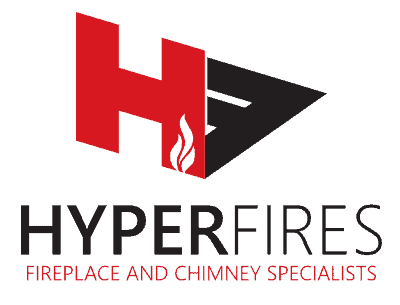No products in the cart.
Buyer's Guide
Chimney Principles
fireplace & chimney specialists | hyper fires
The terms flue and chimney are often used interchangeably.
The flue is the working part of the chimney, conveying the products of combustion safely to the Atmosphere.
The chimney includes the shaft within which the flue is housed.
A flue works under negative pressure drawing the product of combustion from the appliance.
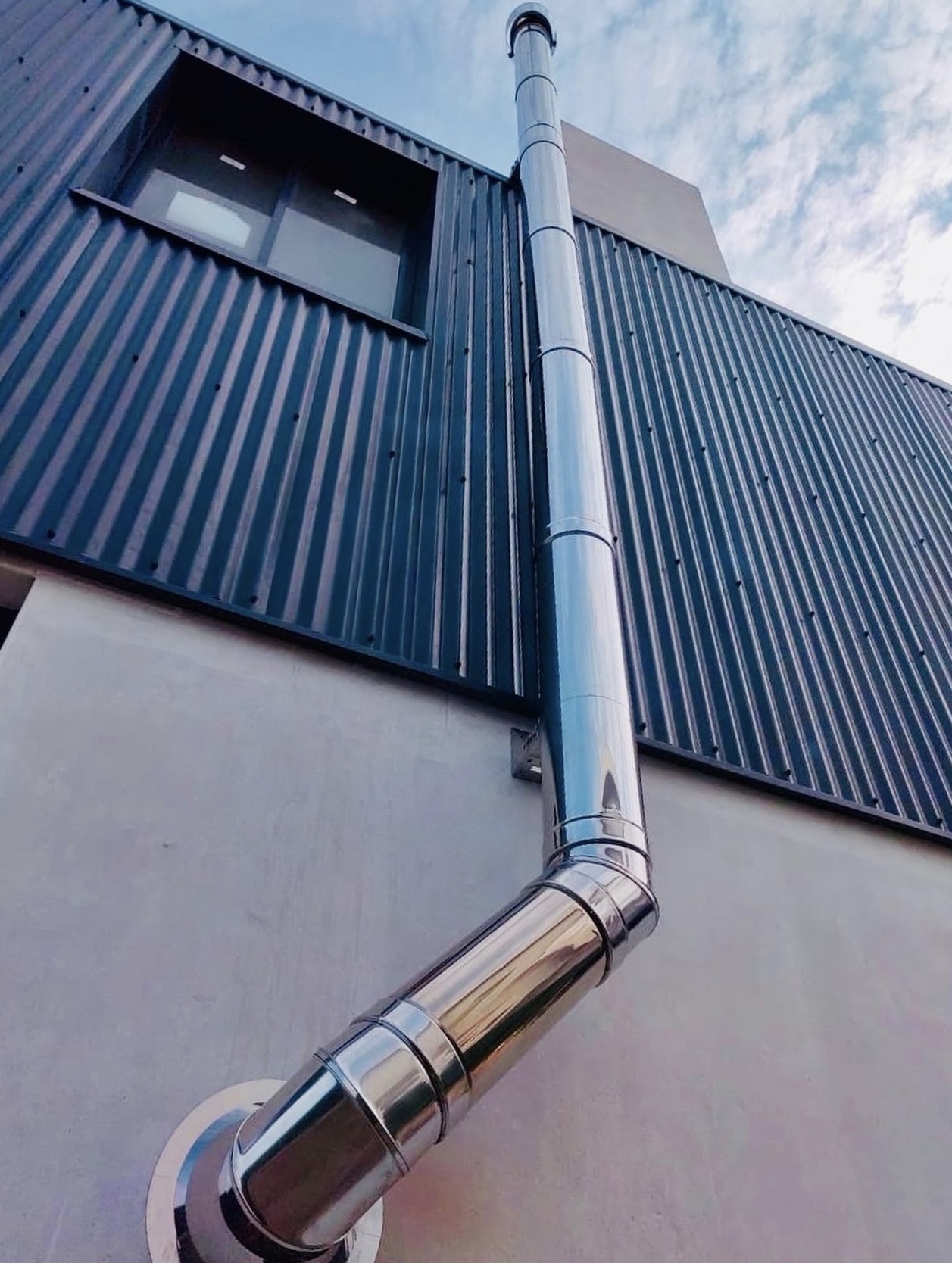
A SUCCESSFUL “CHIMNEY DRAW”
is dependent on the following principles:
- The difference in air pressure between the appliance and the top of the chimney (created by the height of the chimney
- The difference in temperature between the appliance’s exhaust gas and the outside temperature.
- The route of chimney - the straighter and more vertical the chimney the better
- The quality of insulation along the length of the chimney.
Flue Size & Air Supply
It is essential to choose a flue diameter that matches the output from the appliance. An adequate air supply is also required for the appliance to operate safely and efficiently.
Stainless Steel Flexible Liners
- 1Stainless steel fexi flue liners can be used to line the inside of brick chimneys when installing a slow combustion fireplace where there are offsets in the chimney
- 1Aluminium flexi can be used for hot air ducts on buil-in slow combustion fireplaces where they have heating ducts that can push hot air through to other rooms and will not be sufficient to handle the temperature of flue gasses
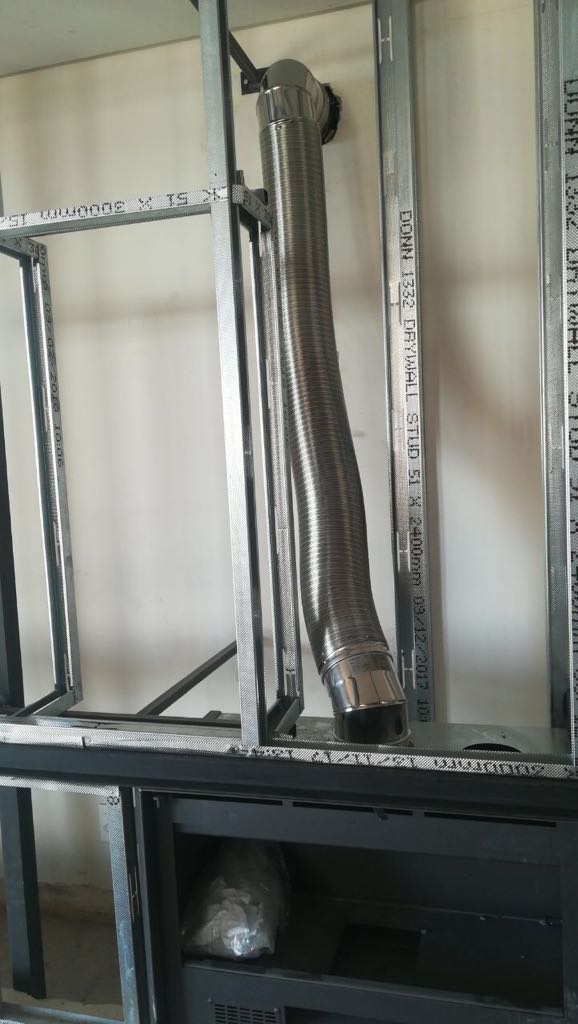

Chimney Position
The ideal location for a chimney is on the inside of the building. That way it can benefit from being kept warm. Chimneys situated outside the building can be affected by cold weather causing poor up draught and condensation, particularly if they are un-insulated. It is therefore important that a cavity wall is continued around a lined masonry chimney or a factory made insulated chimney system is used for external applications. All flues outside the house must be insulated for the following reasons – [1] higher flue temperature to ensure a better draft [2] prevent condensation from forming on the inside of the flue which will cause damage to the fireplace [3] to make the flue system water tight and prevent water from entering the inner flue liner [4] where the flue passes combustible materials prevent a fire hazard.
Connection to the Chimney
For open fires a suitable throated front lintel and gather must be installed above the fire opening, so that the front, back and sides slope up smoothly into the flue opening in the chimney at an angle no greater than 45° from the vertical. Flat surfaces or shelves must be avoided as these can cause turbulence and smoky fires. Most flue and chimney manufacturers provide standard gather and fireplace components. The steel gather and flue lining will also heat up and create a stronger draft inside the chimney. By lining the chimney with a flue liner you will also prevent smoke from being drawn out of the chimney into wall cavities or roof cavities. Where slow combustion fireplaces are installed into existing chimney structures we recommend that the new flue be pulled right through the existing chimney where possible. This will ensure that the new fireplace chimney can be swept in it’s entirety without leaving soot in the outer brick chimney that can cause a chimney fire or odours. It will also help with draft where the outer chimney might be quite a bit bigger and be filled with cold air that will effect startup on your slow combustion fireplace. The new flue liner should just exit the brick chimney at the top and be sealed of with a board or closure plate to prevent backdraft.
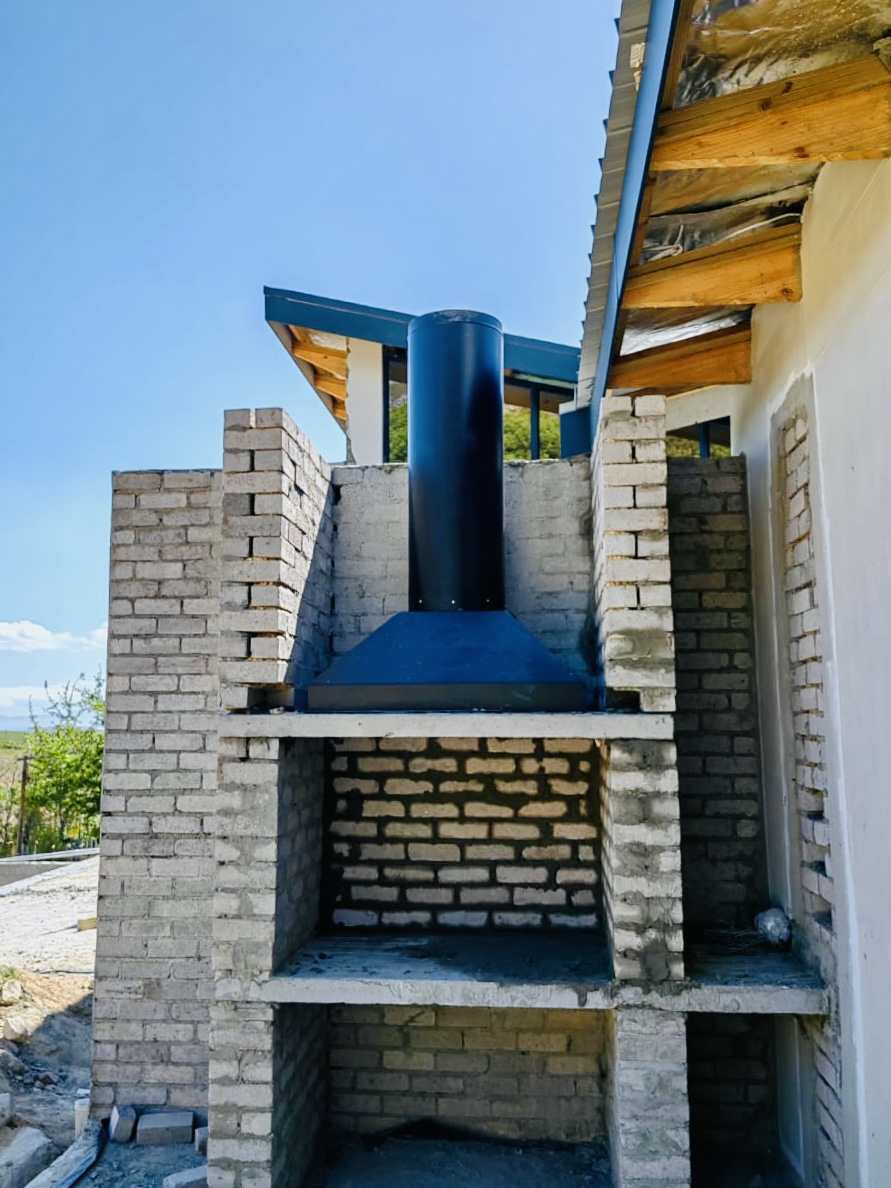
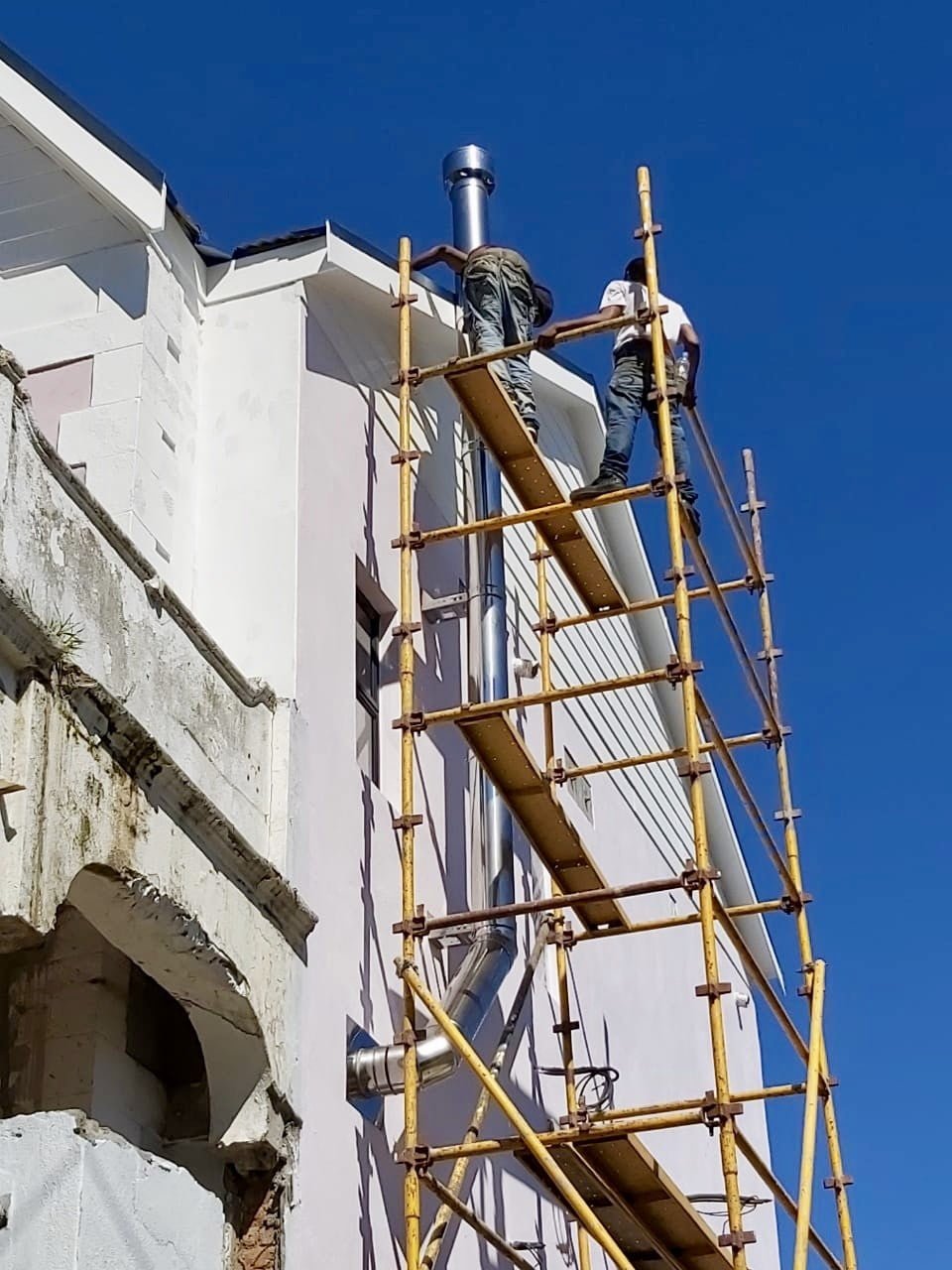
Bends in the Chimney
Both the Regulations and the Standards recommend that bends in the chimney be avoided, as a straight vertical chimney performs better. If bends are necessary there must be no more than four in the length of the chimney. The angle of the bend should be no greater than 45° from the vertical, with the exception that 90° factory made bends [only for slow combustion fireplaces] or tees may be treated as being equal to two 45° bends. Where System Chimneys are used, always use the standard offset components which are available from the chimney manufacturer. For stainless steel chimneys the distance between bends must be no greater than 20% of the total chimney length. It is recommended that a vertical rise of 600mm should be allowed immediately above the appliance before any change of direction. An inspection hatch is required between each offset.
Chimney Heights & INSTALLATION
The minimum chimney height recommended for minimum performance of wood burning and multi fuel appliances is 4.5 m from the top of the appliance to the top of the chimney. It is best to position the chimney, so that it goes straight up as near to the roof ridge as possible. Positive pressure is created from the side which the wind blows from, once it hits your houses roof. Normally smoke will be emitted when the wind blows from the side where the chimney is situated, if the chimney is not high enough. This problem is worse when the angle of the roof exceeds 30 degrees, this creates a higher pressure situation and requires the flue to be taller. This may vary from house to house depending on the surroundings and close by obstructions which the wind may blow over or around. By lengthening the chimney the situation can be resolved. Not more than 1.4m of flue can be left unsupported above the roof level of the house, strong wind conditions can cause the chimney to bend or be blown over.
When Hyper Fires supply a chimney system to our customers we do so in accordance with the principles used in Europe – Dinak’s flue systems carry the highest EU certification in the market. Where ever the chimney enters a roof cavity insulated flues should be used to prevent a fire hazard, this also applies for outside the house to prevent condensate from forming inside the flue and to water proof the chimney. The insulated flue allows for vertical movement on the inner flue and the outer flues stays stationary and thus not breaking the seal on the roof. The transition from single to double wall insulated should always be below the ceiling so that the heat from the single wall flue cant effect the ceiling board. Where roof sheets with a deep pan is used like clip lock and IBR profile the valleys should be blocked of to the highest point with a soaker sheet to prevent water from damming behind the flue and causing water leaks. These soaker sheets will be quoted on by the relevant installer and will be over and above the cost of the installation. All Hyper Fires installations of freestanding fireplaces will always be quoted with a silicone roof boot instead of a stationary seal. The problem with stationary seals is that they crack with the expansion of the flue or in high wind conditions like storms. The silicone roof boot allows for movement on the seal.
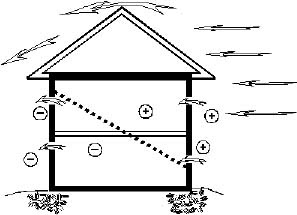

Fuel Burning
A chimney operates on the principle of having a natural up draught. One factor in creating the up draught is maintaining a warm flue gas temperature, of between 150°C and 280°C. Over firing of your appliance will cause discoloration, the degree of discoloration will indicate the degree of over firing [see chart] Burning wood or multi fuel slowly with insufficient air supply, particularly on stoves or closed appliances must be avoided. Low flue gas temperatures will cause condensation and greatly increases the risk of producing excessive tar and corrosive soot deposits. This is a common problem, particularly when burning wet wood or coal and should be avoided. If soot and condensate deposits are allowed to accumulate in a flue, the deposits can ignite causing a chimney fire. These deposits can also be very corrosive and if they are not regularly removed can cause corrosion of the metal parts of both the chimney and the appliance. When burning wood it is important to ensure that it is dry and well-seasoned. If the fireplace does not reach 350 deg C the carbon emitted from the burning of the wood will not be combusted and will collect on the glass and the inside of the firebox.
Regular Inspection
The chimney should be swept regularly to remove soot and tar. At the very least the chimney should be swept at the start of the heating season. It is not recommended that the appliance is over fired, (allowed to burn fiercely and out of control), or chimney fires be started in an attempt to clean the chimney. Deposits of soot and tar will be greatly increased if unseasoned wood is burnt. Should a chimney fire occur, the chimney and appliance should be checked for damage before using them again. It is also good practise to check at least every year or two the exposed parts of a chimney, flashings and terminals for signs of damage. Just like the outside of a house chimneys can suffer from the wear and tear of extreme weathering. If at any time smoke or fumes are apparent or suspected from the appliance, chimney or flue, seek advice immediately from the installer or chimney expert in case there is a blockage or failure. Do not use the appliance or chimney until they have been thoroughly checked for safety and soundness. The escape of fumes can be dangerous.











